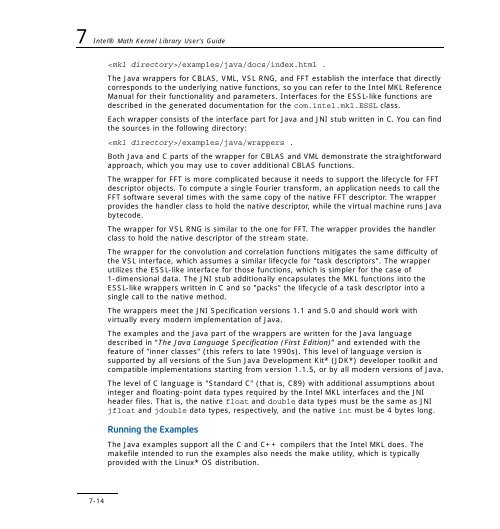Intel(R) Math Kernel Library for Linux* OS User's Guide
Intel(R) Math Kernel Library for Linux* OS User's Guide
Intel(R) Math Kernel Library for Linux* OS User's Guide
- No tags were found...
Create successful ePaper yourself
Turn your PDF publications into a flip-book with our unique Google optimized e-Paper software.
7 <strong>Intel</strong>® <strong>Math</strong> <strong>Kernel</strong> <strong>Library</strong> User’s <strong>Guide</strong>/examples/java/docs/index.html .The Java wrappers <strong>for</strong> CBLAS, VML, VSL RNG, and FFT establish the interface that directlycorresponds to the underlying native functions, so you can refer to the <strong>Intel</strong> MKL ReferenceManual <strong>for</strong> their functionality and parameters. Interfaces <strong>for</strong> the ESSL-like functions aredescribed in the generated documentation <strong>for</strong> the com.intel.mkl.ESSL class.Each wrapper consists of the interface part <strong>for</strong> Java and JNI stub written in C. You can findthe sources in the following directory:/examples/java/wrappers .Both Java and C parts of the wrapper <strong>for</strong> CBLAS and VML demonstrate the straight<strong>for</strong>wardapproach, which you may use to cover additional CBLAS functions.The wrapper <strong>for</strong> FFT is more complicated because it needs to support the lifecycle <strong>for</strong> FFTdescriptor objects. To compute a single Fourier trans<strong>for</strong>m, an application needs to call theFFT software several times with the same copy of the native FFT descriptor. The wrapperprovides the handler class to hold the native descriptor, while the virtual machine runs Javabytecode.The wrapper <strong>for</strong> VSL RNG is similar to the one <strong>for</strong> FFT. The wrapper provides the handlerclass to hold the native descriptor of the stream state.The wrapper <strong>for</strong> the convolution and correlation functions mitigates the same difficulty ofthe VSL interface, which assumes a similar lifecycle <strong>for</strong> "task descriptors". The wrapperutilizes the ESSL-like interface <strong>for</strong> those functions, which is simpler <strong>for</strong> the case of1-dimensional data. The JNI stub additionally encapsulates the MKL functions into theESSL-like wrappers written in C and so "packs" the lifecycle of a task descriptor into asingle call to the native method.The wrappers meet the JNI Specification versions 1.1 and 5.0 and should work withvirtually every modern implementation of Java.The examples and the Java part of the wrappers are written <strong>for</strong> the Java languagedescribed in “The Java Language Specification (First Edition)” and extended with thefeature of "inner classes" (this refers to late 1990s). This level of language version issupported by all versions of the Sun Java Development Kit* (JDK*) developer toolkit andcompatible implementations starting from version 1.1.5, or by all modern versions of Java.The level of C language is "Standard C" (that is, C89) with additional assumptions aboutinteger and floating-point data types required by the <strong>Intel</strong> MKL interfaces and the JNIheader files. That is, the native float and double data types must be the same as JNIjfloat and jdouble data types, respectively, and the native int must be 4 bytes long.Running the ExamplesThe Java examples support all the C and C++ compilers that the <strong>Intel</strong> MKL does. Themakefile intended to run the examples also needs the make utility, which is typicallyprovided with the <strong>Linux*</strong> <strong>OS</strong> distribution.7-14
















